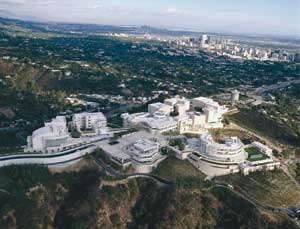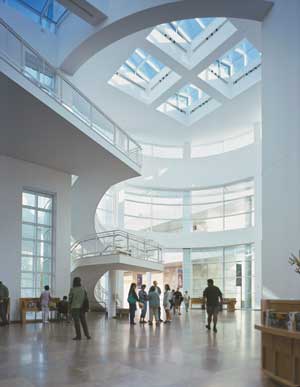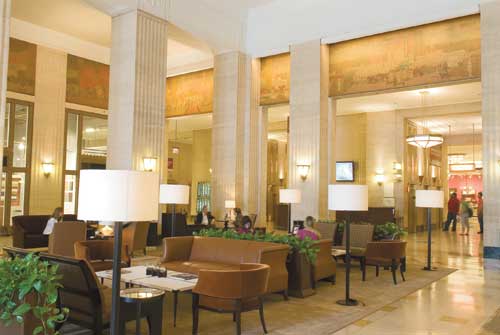LEED for Existing Buildings
Armstrong's team focused on water efficiency in its certification. Replacing conventional urinals with waterless models and converting conventional toilets to dual-flush models-combined with correcting a malfunction in the humidification system-nearly halved the building's water use. The State of Colorado replaced many toilets and urinals in the Capitol Building and added aerators onto faucets. "This is the only area where we changed out equipment to achieve the credit," says Lee.
Energy efficiency usually carries the greatest potential for financial return. Discovery's team began with the building's lighting systems. "For each light bulb, we asked three questions," says Laque: "Do we need that light at all? Do we need that type of bulb? Do we need that level of wattage?" Laque also installed occupancy and daylight sensors in appropriate areas and worked with vendors to turn off the lights in the vending machines.
 |
Los Angeles' Getty Center was the first building to receive LEED-EB certification after the USGBC's original pilot program. Photo courtesy J. Paul Getty Trust |
Recertification
To keep their LEED-EB certifications current, owners must recertify each building at least once every five years. Arny encourages building owners to recertify annually, however. "If you're doing something wrong and don't find out until year five, that can be pretty deflating," he explains, adding that "annual recertification allows organizations to build LEED-EB into how they operate."
Because of this recertification requirement, targeting a particular level of certification is somewhat different for LEED-EB than it is for LEED-NC. "New construction is a one-shot deal," says Arny. "You get the score you get." In LEED-EB, though, "you have the rest of the life of the building to improve." For this reason, many building owners use the first certification process to benchmark their performance-making upgrades only where necessary to achieve certification-and use subsequent certifications to raise performance. Los Angeles' Getty Center, the first project to earn a second LEED-EB rating, followed this strategy. It earned 35 points, for a basic Certified rating, in January 2005. Slight improvements combined with more thorough documentation, however, allowed the Getty Center to earn 47 points, for a Silver rating, in April 2008. "As we come up to recertification again, we'll see if there are other things we can add," says Mike Rogers, Getty's director of facilities.
 |
Completed in 1997, no facility improvements or new construction were required for the Getty Center to achieved LEED-EB status. The original construction was environmentally friendly enough for the property to qualify after sufficient data was collected by the facility director. Photo courtesy J. Paul Getty Trust |
Other teams target a high level of certification from the get-go. Adobe Towers, a three-building complex in San Jose, California, "was baselining at Gold, but had Platinum in their sights," says Hammond, who consulted on both Adobe and Getty. "They started making some changes and upgrades, but that was their choice," she stresses. Adobe's team made enough upgrades, mostly related to energy efficiency, to qualify the project for a Platinum rating in December 2006.
After the first certification is complete, Re:Vision encourages facilities teams to "stay on top of the tracking that they've gotten used to during the first performance period and continuously look for ways to improve," says Craig. Baker says that Armstrong monitors performance and has assigned goals to specific individuals. "They'll be responsible," he says, "and their pay will be tied to that performance." As a result, "the next round hopefully will just be a matter of pulling all our data together."
Timing
The amount of time required for certification depends heavily on the project's existing operations and maintenance practices. Those who have been through the process recommend starting early and focusing on the prerequisites. Getty's Rogers says that his staff put a lot of other responsibilities on hold to focus on their first certification and eked out the rating in about five months. Craig says that certifying Armstrong took just over one year. Both of these organizations had been improving their environmental performance for several years, however, and began the process with a lot of information already assembled. Also, both teams opted to minimize capital improvements. For projects that need more significant work, identifying the problems, designing and implementing the solutions, and tracking the performance of those solutions can drag the process out to anywhere from 18 to 30 months, or even longer, according to Craig.
The time investment will likely increase. LEED-EB version 2.0 allowed project teams to extrapolate the building's annual performance based on three months of energy data, but O&M requires a full year of data. As with many other consultants, Craig remains on the fence about whether this change is positive or negative. "LEED-EB isn't supposed to be about making predictions and cooking the books," he says, but on the other hand, "you don't want to see projects give up on LEED-EB due to the time commitment."
 |
|
 The Merchandise Mart in Chicago is considered the largest commercial building in the world, making its LEED-EB Silver certification all the more impressive. Photo courtesy Merchandise Mart Properties |
 |
Â









